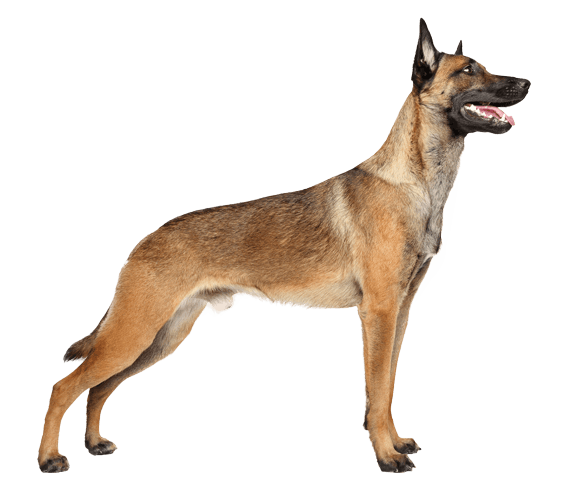Belgian Malinois Breed Maintenance
Do Belgian Malinois shed? Yes, but not extensively compared to many other breeds and, coming from hardy stock, the Belgian Malinois doesn’t need much by way of grooming.
Brushing your dog once a week will help keep their coat tidy, although you might need to do it more often during their shedding periods — this will make your home considerably tidier, too!
Bathing should be kept to a minimum as doing it too much can affect the coat’s waterproof properties — but don’t hesitate to do so when this outdoorsy dog has rolled in something particularly pungent on one of their walks.
Belgian Malinois Health Risks
Belgian Malinois are generally considered a healthy breed, but like all dogs, they can be prone to certain genetic and hereditary health issues. There are some joint issues, eye problems, and some general conditions to be aware of as a pet parent.
Hip dysplasia
Hip dysplasia is a genetic disorder affecting the hip joint, leading to arthritis and discomfort. It happens when the hip bone and joint become misaligned, leading to them grinding together when the leg moves rather than running smoothly.It's essential to maintain a healthy weight and regular exercise routine to minimize the risk. Screening for this condition in young puppies can help identify any early signs. If you notice any limping, lameness, swelling or general discomfort, it might be time to give the vet a call.
Elbow dysplasia
Elbow dysplasia can cause lameness and joint discomfort in the front legs. As a pet parent, it’s important to monitor your Malinois’ mobility and talk with a vet if you start to notice any signs of limping or discomfort.Progressive Retinal Atrophy (PRA)
PRA is a degenerative eye condition that can cause blindness over time. Although it’s a hereditary issue (that unfortunately can’t be cured), regular eye exams can help catch early signs, allowing you to make lifestyle adjustments as needed for your dog.Cataracts
Cataracts are common in aging dogs and cause a cloudiness in the eye lens, eventually leading to impaired vision or blindness. Surgery can be an option for dogs with advanced cataracts, but early detection is key.Epilepsy
Epilepsy is a neurological condition that results in seizures. While it can’t be cured, it can be managed with medication and lifestyle adjustments. If your Malinois experiences seizures, it’s important to work closely with a vet for proper diagnosis and treatment.Bloat (Gastric Dilatation-Volvulus)
Bloat, or GDV, is a potentially life-threatening condition where the stomach fills with gas and can twist, cutting off blood flow. If this happens to your pup, make sure you contact your vet immediately. Feeding your Malinois smaller, more frequent meals can help reduce the risk of bloat.Pannus
Pannus is an inflammatory eye disease that can affect the vision of a Belgian Malinois. Treatment options include lifelong management with medications to slow the progression of this disease.Rage Syndrome
Belgian Malinois are one of the few breeds associated with the little-understood rage syndrome, which is when a dog becomes aggressive and potentially dangerous seemingly out of the blue.
It’s thought to be a form of seizure in the brain’s temporal lobe and hereditary in nature, too. However, the exact cause isn’t known, which makes it a difficult condition to diagnose.
If your vet does land on this reason for your dog’s abnormal behavior, they might prescribe anticonvulsant medication to try to limit the outbursts. Family members, especially young children, should be warned of the signs to look out for ahead of a seizure, too — the Belgian Malinois bite force can be quite strong.
Is your Mal insured? If not, check out Wag! Compare. Browse hundreds of insurance plans and find the right one for your pup’s lifestyle, and stay ahead of any health emergencies that might come your way.
Feeding a Belgian Malinois — What’s the Best Food?
A well-balanced diet is crucial for a Belgian Malinois to maintain its high energy levels and overall health. High-quality dog food formulated for active breeds is typically the best option, but some owners opt for a raw or homemade diet, provided it meets their dog’s nutritional needs.
When it comes to mealtimes, an adult Belgian Malinois dog doesn’t have any special requirements. A top-quality dog food full of protein, carbs and vegetables will suffice, and our partner Dog Food Advisor has a long list of recommendations.
Belgian Malinois puppies may need more specialist food during those early months; take a look at our selection of best large breed puppy food suggestions and find a new favorite for your little one today!
You might find your pet needs a fair amount of food every day to replace the energy exerted on your walks. However, you should ensure that your dog isn’t being overfed — this can lead to obesity and an array of nasty secondary conditions.
Make sure your Malinois has access to clean, fresh water throughout the day, especially during and after exercise.
Keep your pup hydrated — find out how much water dogs should drink per day.




